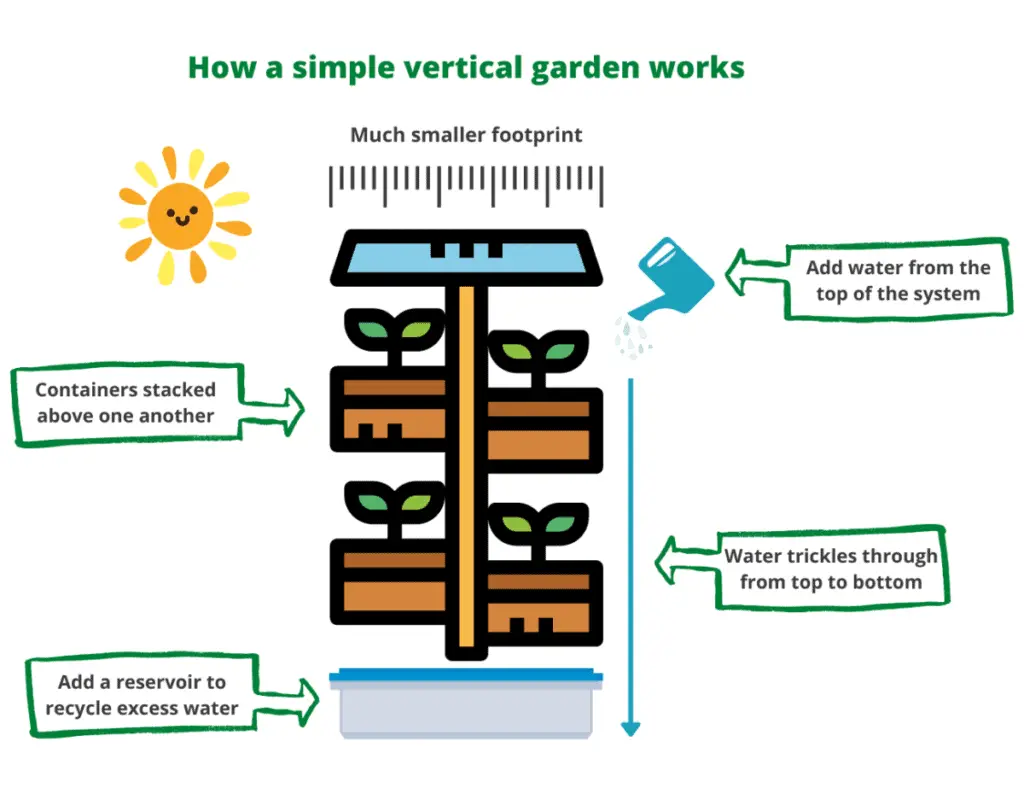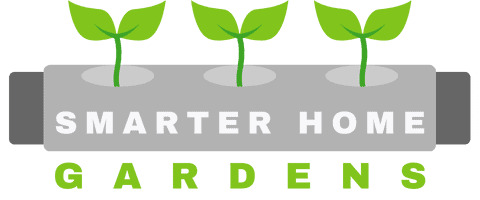
As a sustainability professional myself it is important to me that my garden results in positive outcomes for the planet. I didn’t want to use too much fertilizer or any pesticides. And I didn’t like the idea of wasted water, especially as the planet warms and droughts become more common. I needed to create a garden that was efficient, productive, and sustainable. Luckily, vertical gardening had the answer.
Vertical gardening is widely considered a sustainable way to grow crops at home. As a general rule, vertical gardens use less water, fertilizers, and pesticides and absorb more carbon dioxide per square foot than conventional gardens.
In this post, I will share with you everything I have learned about why vertical gardening is a more sustainable option for the planet. I’ve even learned a few nice surprises along the way.
How are vertical gardens more sustainable?
Vertical gardens are more sustainable than traditional gardens in a number of ways. From using less water to absorbing more carbon dioxide, vertical gardens are great for the planet. Let’s explore precisely how.
Vertical gardens use much less water
Generally, vertical gardens use less water than conventional gardens. Depending on the method used, a vertical garden can use up to 95% less water. This is because water is not wasted in the surrounding earth with any excess often captured and stored in a reservoir before being recycled.
Mainly, vertical garden systems use less water because you can apply it more directly to each plant and then capture and recycle it rather than allowing it to leech into the ground.

By stacking or hanging pots, planters, and other containers above one another nutrient-rich water is allowed to seep through to each lower level before collecting in the reservoir at the bottom.
Among the most water-efficient vertical gardening systems are tower gardens. These are enclosed ‘all-in-one’ aeroponic units, complete with automated pumps to keep the same water flowing through the system continuously.
If you want to learn more about hydroponic or aeroponic gardening, I’ve written a whole article about the different types of hydroponics systems. Check it out if you like.
It’s the same sort of technology used in commercial vertical farms and can save water by up to 95%.

With bills going up, saving water can also save you money, which is a nice bonus. The amount of water you can save depends on the type of vertical garden system you use and the quality of the build.
I’ve written an in-depth article on the different types of vertical gardens in another post.
Vertical gardens can help to fight climate change
Vertical gardens can help to fight climate change by absorbing carbon dioxide from the atmosphere. By growing plants vertically, it’s possible to absorb more carbon in a smaller surface area using vertical gardening as opposed to traditional gardening.

Green walls have long been used as a way of absorbing carbon in cities and improving the air quality within office buildings.
Studies have shown that 1m2 of green wall made from mosses can absorb up to 2kg of CO2 and produce 1.7kg of oxygen each year. While it isn’t huge, it’s certainly better than nothing.
But while we may not be able to achieve the same scale in our homes, creating a vertical garden (be it a green wall, containers, or tower systems) can still help. One of the biggest advantages of vertical gardening is that you can grow many more plants using far less space.

It’s a simple equation: more plants equal more carbon removed from the atmosphere.
Vertical gardening has allowed me to grow far more than I otherwise would have in my small, urban garden. I may not be changing the world myself, but I am doing my bit to reduce my own carbon footprint.
Vertical gardens are better for nature and biodiversity
Vertical gardens can be a great way to create biodiverse structures that provides more space and vegetation for insects, birds, and other types of animals. They are particularly valuable in urban areas where animals are more deprived of their natural habitats.
The more plants you can grow the better it is for biodiversity. Since starting my own vertical garden I’ve been able to grow far more flowers, herbs, and vegetables than I ever could using conventional methods.
I’ve noticed a big increase in the number of bees in summer, as well as other insects ladybugs (which are great for controlling pests).

Resultingly, my garden has become home to a family of sparrows and is often visited by other small birds. Creating a biodiverse space with vertical gardening is good for the planet and I’m looking forward to adding more and more plants over time.
Vertical farming uses fewer fertilizers
Owing to the small bed size vertical gardens may require fertilizing a little more often, but will ultimately use less fertilizer than conventional ground-based gardens.
I find that every 2-4 weeks works well with my vertical garden. Because I’m able to target fertilizer more easily to each plant less is wasted and each bag or bottle of feed tends to last much longer.
Additionally, the nutrient-rich water is recycled through the system, meaning that the plant is able to absorb more fertilizer over time.
Vertical gardens can help to save energy
Some types of vertical garden systems can even save you energy. Green ‘living’ walls can act as an insulation layer by slowing down airflow, keeping rooms naturally warmer and winter and cooler in summer.
This insulating effect can, in theory, help to reduce the amount of energy (derived from fossil fuels) needed to heat or cool your home, which is better for the environment.
It can also help to save you money on your energy bills. However, while the theory is provably true, the impact on individuals is minimal but more pronounced for people who live in hot/cold countries.
Can you grow your own food in a vertical garden?
Vertical gardens are a great, cheap, and eco-friendly way to grow your own food at home. Vertical gardening is perfect for growing herbs, leafy greens, and many types of vegetables and reduces your reliance on shop-bought equivalents.

By growing your own food at home, you can reduce its carbon footprint by limiting the distance it needs to travel to reach your plate. As an example, according to the My Emissions Food Footprint Calculator, 1kg of Green Peppers can cost as much as 2kg of CO2 to produce commercially.
By growing the same at home, you can dramatically reduce this figure as there is no travel or other high-carbon emitting processes used.
Some great examples of foods you can grow in a vertical garden are:
- Chives
- Lettuce
- Chilies
- Herbs (most types work great!)
- Tomatoes
- Beans
And, it’s not just leafy greens or herbs you can grow in a vertical garden either. I’ve written an article about growing root vegetables in a vertical garden, like sweet potatoes, garlic, and even carrots. Please have a read to learn more.
Final thoughts
Vertical gardening is a sustainable form of gardening and a great way to create positive outcomes for both the environment and the creatures that live within it.
By growing a greater density of plants per square meter, vertical gardens have the potential to use much less water, absorb more carbon dioxide from the atmosphere and emit more oxygen than other methods of gardening.
Green ‘living’ walls can improve the air quality of office spaces and living rooms alike, and help to marginally reduce our dependence on energy for heating and cooling our living spaces.
Furthermore, more greenery means more biodiversity. Vertical gardens are a fantastic tool for increasing the number of insects, birds, and other beasties in your garden – especially if that garden is an urban one.
All in all – vertical gardening is a win for the planet.
